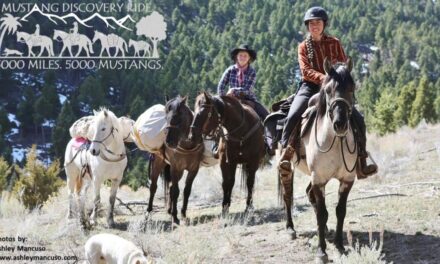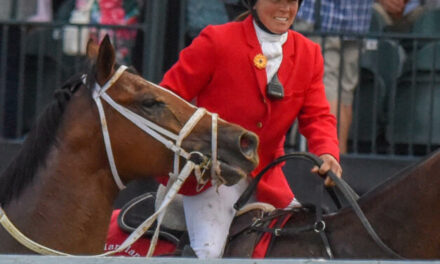(updated in the August 2020 Equiery)
While COVID-19 has shut down many activities throughout the country, according to the American Horse Council, people are flocking to horseback riding due to its inherent amenability to social distancing and outdoor venues. Here in Maryland, horseback riding was one of the first outdoor activities permitted by Governor Hogan’s executive orders, even before Phase 1 of his recovery plan was initiated. Because of this, many lesson stables are seeing an uptick in new students.
The Equiery reached out to the 38 Horse Discovery Centers in Maryland and while many stated they are purposely working at a smaller capacity than pre-COVID, they are getting more phone calls requesting lessons, and some even have growing wait-lists.
If you are new to horseback riding or looking for a new, socially distant activity for your children, picking the right lesson stable can seem daunting. To help guide new riders toward the perfect lesson stable fit, The Equiery created its “Learn to Ride!” guide in 2003.
To learn more about the Maryland Horse Industry Board’s Horse Discovery Centers go to www.mda.maryland.gov/horseboard. To find a lesson stable, go to https://equiery.com/stables/
Stable Facilities
The Maryland Department of Agriculture, through the Maryland Horse Industry Board, inspects public stables to ensure that the care of the horses and riding equipment meets certain minimum standards. Currently there are over 700 licensed stables in Maryland.
Licensed stables must display Maryland Department of Agriculture license certificates prominently on the premises. However, MDA licensing does not ensure the quality of instruction.
Instructors
Although Maryland does not require that instructors be certified or licensed, there are many national and international programs that offer teaching certifications. Some of these organizations with certification programs include, but are not limited to:
• The American Riding Instructors Certification Program (ARICP)
• The British Horse Society (BHS)
• Certified Horsemanship Association (CHA)
• Professional Association of Therapeutic Horsemanship International (PATH Intl.)
• United States Dressage Federation (USDF)
• United States Eventing Association (USEA)
In addition, many colleges offer equine studies degrees, which include certification programs, or their equivalent.
These certifications do not necessarily attest to the quality of instruction, or the integrity of the instructor. They only certify that the individuals have a certain amount of knowledge and/or training. Some certifications do not require any updating, while others require periodic renewal with proof of continuing education.
The majority of these programs also require instructors to maintain proper certification for First Aid and CPR through an accredited national or international organization. Those teaching within the umbrella of the U.S. Equestrian Federation and U.S. Pony Club, Inc., are also required to complete the SafeSport training program and complete yearly refresher courses.
Please note, there are many outstanding instructors who hold no certification whatsoever. One of the best ways to learn more about an instructor before signing up for a lesson program is to watch them teach a few lessons and use your own judgement.
Finding a Lesson Stable
When starting the search for a lesson stable, the first thing to do is ask yourself a few simple questions:
1) Are you looking for a stable that caters strictly to adults? Strictly to children? Or a mix of both adults and children?
2) Do you want to ride English or Western? (There are many sub disciplines involved in both English and Western riding, but for first time riders, we suggest picking one style to learn first and then decide if you want to switch or pursue a specific discipline.)
3) Do you want to ride for pleasure, or do you (or your child) have aspirations to show or compete?
The answers to these questions will dictate the direction of your search for the perfect lesson stable.
1) Some stables specialize in only children or adults, and others are comfortable doing both. You need to be comfortable with the others who may be in the lessons with you or your child.
2) Many riders begin their lessons knowing which type, English or Western, that they want. Others do not. Some barns can provide introductory lessons in both styles of riding, and students later specialize once they have decided which they prefer. Neither style is better than the other.
3) Although competing is not necessary to enjoy horses, many people enjoy showing and competing, while others have no desire to compete. Some barns do not offer competition opportunities while others allow students to compete, but do not pressure students to compete if they are not interested. Other barns are primarily geared towards competing, so it is important to decide where you fit in the spectrum.
Of course, your long-term riding goals are subject to change and many riders find they shift stables at times to fit their changing needs. Assessing your needs honestly and accurately in the beginning may save you lots of money, and help avoid the expense of signing up with a program that really just does not suit your needs.
Narrowing the Field
Now that you know what type of lessons you want, what next? We recommend selecting a few stables that meet your requirements, and visit them! Many stables host regular “open houses” and introductory lessons. Take this opportunity to speak with staff and other students (or even other parents, if you are looking for a lesson barn for a child).
Please be sure to call ahead to find out if the stable is a “public” facility open to the public during business hours, or a “private” facility that you must schedule an appointment to visit. We recommend you visit the facility more than once if possible.
While visiting potential lesson stables, ask yourself the following questions:
1) Staff
• Does the staff respond to inquiries in a friendly and helpful manner, in person, and over the phone/via e-mail?
• Does the staff appear to be knowledgeable about horses, teaching, and business management?
• Do the instructors continuously monitor the lesson for safety?
• Do the instructors work with each rider to develop and attain goals that allow for individualized success?
• Do the instructors use diverse instructional strategies to communicate to students in a positive and effective manner that promotes a growth mindset and celebrates success?
2) Horses
The horses are just as important as the instructor to the success of riding lessons. Even if you know nothing about horses, there are some basic indicators about a horse’s health. Simple things to look for include shiny coats and a happy attitude so ask yourself while visiting a lesson stable:
• Do the horses seem happy with their jobs, healthy and well cared for? (Each horse is different on any given day, but is the overall impression of the school herd a positive one?)
3) Students
• Do the students seem happy to be in class? (Even the most seriously concentrating student should smile at some point during the lesson!)
• Do they seem excited about the lesson? (Students who are happy about their lessons are eager to get started!)
4) Safety & Responsibility
• Does the barn stress safety when riding and working with horses? (Riding can be a dangerous sport and it is vital that lesson facilities teach students how to ride and work around horses in the safest manner possible. )
• Is the tack and equipment used by the students and horses clean and in good repair? (Tack should be well oiled, free of tears and with stitching in good shape. If helmets are provided, they should bear labeling attesting that they meet safety standards, and look relatively new as helmets should be replaced every few years.)
5) Facility Maintenance
• Is the overall impression of the barn one of neatness and tidiness? (Barns do not need to be spotless but should be reasonably well maintained, free of trash, and have equipment properly stored. Aisles should be free of clutter to allow safe passing of horses.)
Make the Most Out of Your Riding Experience
Riding is a fun and enjoyable learning experience. Here are a few tips to get the most out of your lessons.
• Be on time, or even a bit early!
• Be sure to consider the horse’s welfare before and after the lesson and ask your instructor what you can do to help with the horse’s day to day care.
• Listen to the instructor and avoid chatting with others during your lesson.
• Wait for the instructor to tell you the lesson is over before dismounting.
• Be sure to thank your instructor at the end of each lesson.
• Try to avoid excessive cancelling and rescheduling of lessons. It disrupts the barn’s routine and it interferes with your learning process.
• If you have concerns about the lesson program or your progress, ask to chat with the instructor or program head outside of lesson times.
• If possible, offer to help out around the barn by sweeping the aisleways or cleaning tack and you will quickly learn more about horses than just the riding part!











